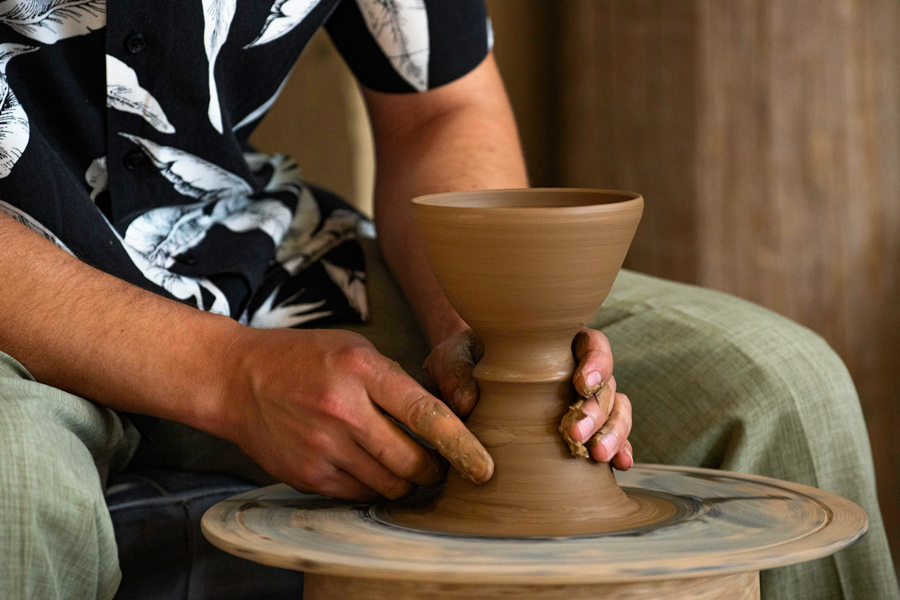The crafts of Uzbekistan are remarkable for their diversity and deep-rooted traditions. Intricate patterns on ceramics, carpets, and textiles weave together a visual chronicle that continues to tell the story of the country's culture and daily life, even centuries later. Passed down from master to apprentice, these designs are meticulously recreated through generations, keeping the spirit of past eras alive today.
The distinctiveness of Uzbek craftsmanship is recognized well beyond the country’s borders. Renowned examples include Rishtan ceramics, Margilan textiles, and Bukhara carpets - all of which have become cultural symbols of Uzbekistan. Beyond these celebrated names, cities such as Tashkent, Samarkand, Bukhara, Fergana, Kokand, and Khiva each foster their own respected schools of craft. These centers preserve and develop a wide range of traditional arts, including ceramics, wood carving, carpet weaving, textile production, embroidery, national garment sewing, miniature painting, and metal engraving.
We’ve compiled a list of renowned artisans in Uzbekistan whose handmade products are regularly featured at craft fairs, as well as local and international exhibitions. You’ll also discover their workshops – places where pieces are created and sold, and where tours and master classes invite you to explore the rich world of Uzbek traditions more deeply.
Ceramic Artists of Uzbekistan
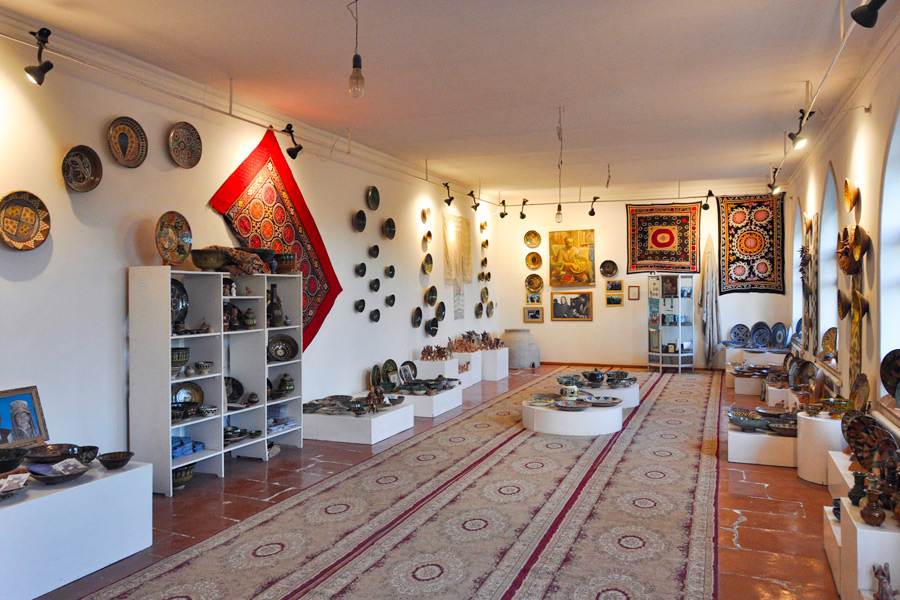
Akbar Rakhimov (Tashkent) is a gifted fifth-generation ceramist, artist, and potter, as well as an Honored Academician of the Academy of Arts of Uzbekistan. He co-founded the Rakhimov Ceramics Studio in Tashkent and established the Master-Apprentice pottery school. Additionally, he opened a house museum dedicated to his father, Mukhitdin Rakhimov, a renowned Tashkent ceramist and People's Artist of the Uzbek SSR.
Today, Akbar Rakhimov and his son Alisher continue to preserve traditional ceramic techniques while developing innovative designs for their creations. Their works are showcased not only in Uzbekistan – through displays in their workshop and various exhibitions – but also internationally, with presentations in Russia, Germany, and Japan.
Alisher Nazrullaev (Gijduvan) is a seventh-generation ceramist, an academician of the Academy of Arts of Uzbekistan, and the recipient of numerous awards. He has also participated in many international exhibitions. Together with his brother Abdullo, he preserves the ancient traditions of Uzbek handicrafts, continuing the legacy of their father, the nationally recognized master Ibodullo Nazrullaev. Their dedication keeps the rich heritage of Gizhduvan ceramics alive.
In his craft, Alisher follows every stage of ceramics production, from preparing the right clay to firing and painting, maintaining time-honored Uzbek pottery traditions. His authentic tableware, decorative pieces, and whimsical whistling toys stand out for their dominant brown and green hues, a signature of the Gizhduvan school. These traditional Uzbek crafts often feature original ornaments with plant and animal motifs such as the “peacock flower”, “eagle's tail”, and “white bird”, typically rendered with softly blurred contours – a distinctive hallmark of the region’s style. You can see his work firsthand at the Narzullaev family’s ceramics workshop in Gijduvan.
Said Akhmedov (Rishtan) is one of the most renowned master potters in Rishtan. The pottery of this region is easily recognized by its intricate ornamentation, blue and turquoise hues, and distinctive ringing sound. Said Akhmedov’s work skillfully blends tradition with innovation, giving his ceramics a modern, individual character that stands out among Rishtan ceramics.
His artistry has long been cherished by customers not only in Rishtan but also in Tashkent, where he established his own workshop, “Said’s Ceramics”. Visitors to the old part of the city can explore the vibrant world of Rishtan pottery, taking part in master classes that guide them through every stage of creating a piece – from shaping it on the potter’s wheel to painting it with graceful ornaments.
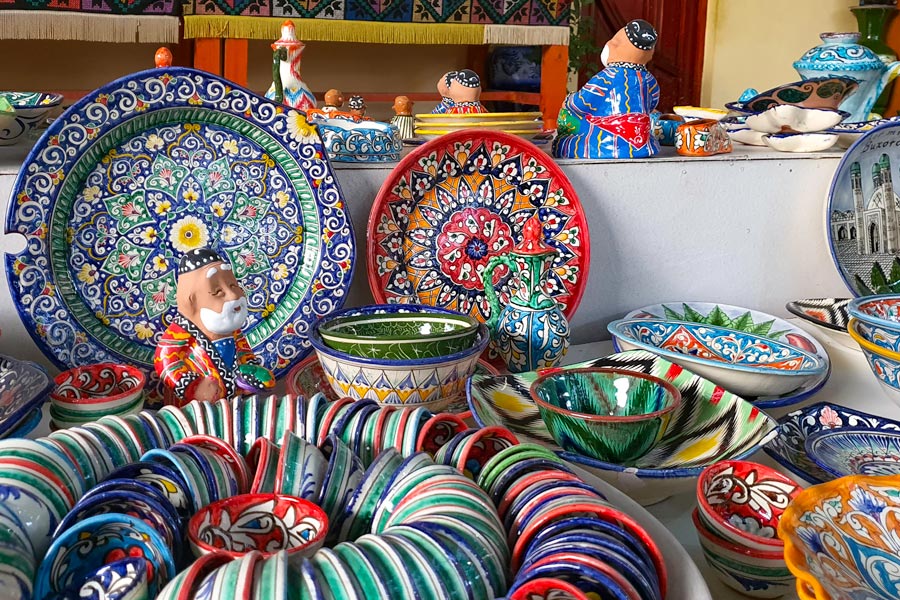
Alisher Nazirov (Rishtan) is a skilled master whose works enrich museum collections around the world, including in Russia and Japan. His creations are also regularly showcased at exhibitions and craft fairs in Uzbekistan, helping highlight the beauty of Uzbek crafts and drawing crowds at every major craft fair Uzbekistan hosts. Nazirov’s style is celebrated for its vividness and originality. While rooted in the traditional blues and turquoise of Rishtan ceramics, his palette often features beige and brown tones, all carefully chosen from natural pigments to produce stylish, sought-after pieces.
The craftsman insists that no two of his works are ever the same – each is truly unique. Alisher Nazirov’s main workshop is in Rishtan, but his ceramics can also be seen and purchased in other cities across Uzbekistan, including Samarkand and Tashkent.
Rustam Usmanov (Rishtan) is an outstanding contemporary ceramist and a student of the legendary Rishtan master Ibrahim Komilov. A recognized expert in painting, including historical painting, he explored ancient techniques through materials uncovered by archaeological expeditions. Today, the intricate patterns adorning his pottery revive the ornaments of the past, breathing new life into traditional Uzbek crafts and enriching the legacy of Rishtan ceramics.
Visitors can admire Usmanov’s work in his museum, where he not only showcases his own creations but also presents older examples of Rishtan pottery. Committed to preserving this heritage, he now shares his art with children and numerous students, ensuring that the traditions of Uzbek ceramics continue to flourish for generations to come.
Vakhobjon Buvayev (Gurumsaray) is a celebrated craftsman in Uzbekistan and the finest student of the renowned Gurumsaray master Maksudali Turopov. He is dedicated to reviving the almost forgotten local school of ceramics, distinguished by its green and blue ornaments on a white background, and bringing this unique tradition back to life.
The master frequently participates in cultural events. The largest of these was his solo exhibition, Continuing Traditions, held at the Tashkent House of Photography in May 2025. It featured more than 300 of his works, including richly decorated legans and jugs, as well as toys and khushtak whistles, showcasing the breadth of his craft.
Uzbek Woodcarving Masters
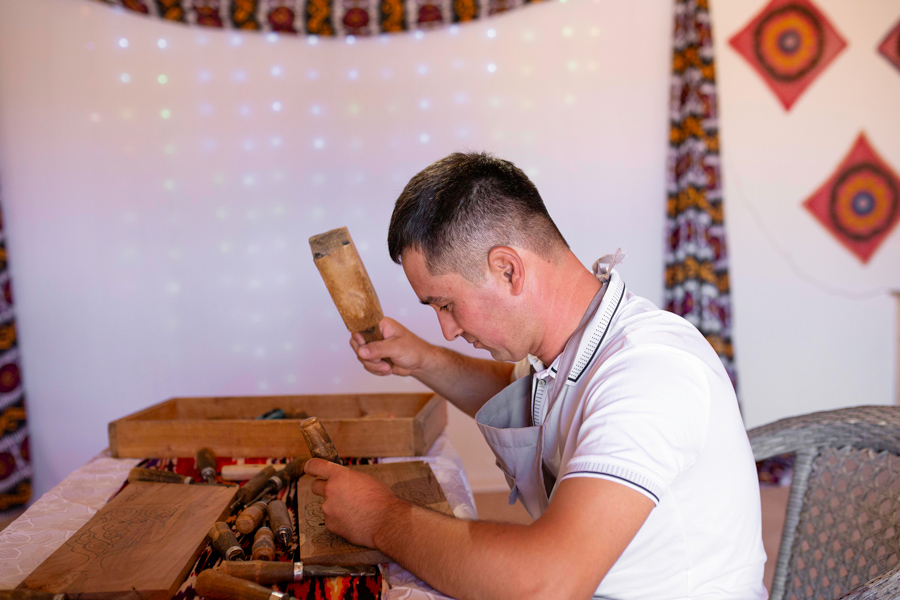
Odamboy Masharipov (Khiva) is one of Uzbekistan’s finest craftsmen and a recipient of the prestigious Presidential Award. A dedicated follower and prominent representative of the Khiva school of wood carving, he continues a tradition that traces back to the celebrated 19th-20th century Khiva master Ata Palvanov.
In his work, Masharipov blends classic motifs with fresh, innovative details. He creates small interior and household items such as tables, chairs, and intricate wooden miniatures of historic Uzbek buildings. His artistic journey also includes major projects featuring large carved gates and columns. At his workshop, Odamboy Masharipov teaches numerous students, sharing with them the secrets of this ancient craft to ensure its traditions live on.
Akmal Azlarov (Tashkent) is a renowned craftsman who has earned numerous accolades, including the Medal of Honor. He is dedicated to advancing the art of wood carving, one of Uzbekistan’s most significant traditional crafts. Among his many creations, his distinctive multi-storey sliding bookstands stand out – pieces that demand both exceptional skill and creative ingenuity.
To ensure that this art form continues to flourish, Akmal Azlarov established his own woodcarving school in Tashkent. Here, he passes on his knowledge and techniques to future generations of carvers, helping preserve and enrich this important cultural heritage.
Carpet Weavers and Embroiderers of Uzbekistan
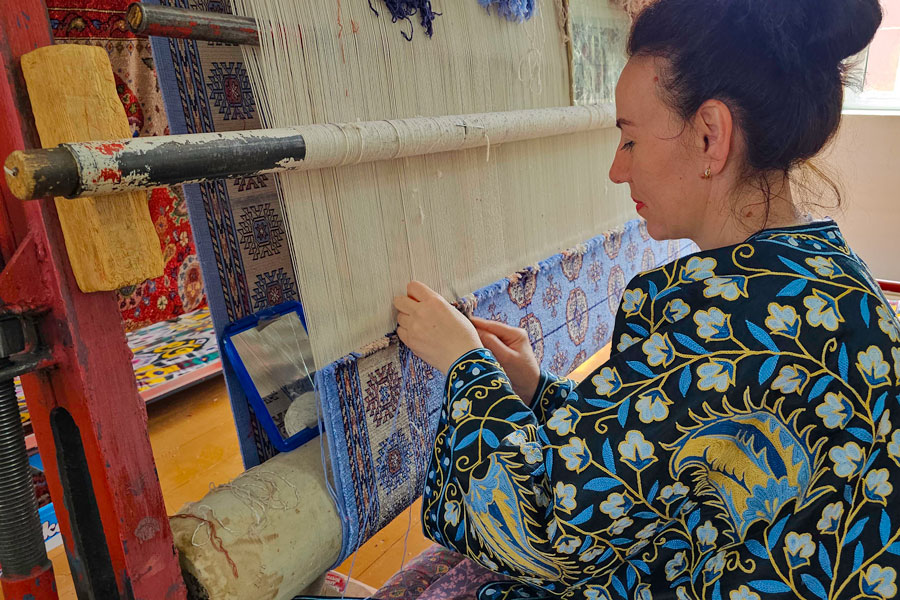
Sabina Burhanova (Bukhara) is a celebrated master of Bukhara carpet weaving. In 2023, she was featured on the Homo Faber list of distinguished Uzbek artisans. Her spacious workshop, Bukhara Silk Carpets, also serves as a retail space offering a wide selection of handmade silk and wool carpets. Each piece is crafted with natural dyes and distinctive patterns. Burhanova’s works stand out for their exceptional quality and refined beauty, often featuring the signature red hues of the Bukhara style – a color that symbolizes flame and energy.
Edris Badgisi (Samarkand) is a hereditary carpet weaver and descendant of Khoja Mohammad Evaz Badgisi, the founder of the Samarkand Bukhara Silk Carpets factory, more widely known as Hudjum. Today, the factory employs over 450 women who uphold the ancient art of carpet weaving, performing each stage entirely by hand. Edris Badgisi and his family place great emphasis on the emotional well-being of their craftswomen, guided by the philosophy that “a happy worker creates beautiful carpets”. As a result, each artisan works in a comfortable environment that encourages both skilled craftsmanship and the infusion of positive energy into every product.
Madina Kasimbaeva (Tashkent) is a renowned master of suzani embroidery who has received numerous honors, including the Shukhrat Medal and inclusion in the Homo Faber Guide. She continues the tradition of authentic Tashkent suzani embroidery, and her exquisite creations have been exhibited worldwide, with some even entering the collection of the British Museum. In Tashkent, Kasymbaeva has established her own showroom and designer label, Suzani by Kasymbaeva. Her elegant chapanas and dresses are frequently chosen by public figures, including Saida Mirziyoyeva, daughter of the President of Uzbekistan; her sister Shakhnoza Mirziyoyeva; Chairwoman of the Uzbekistan Culture and Arts Development Fund, Gayane Umerova; and other prominent personalities.
Rakhim Toshev (Bukhara) is another distinguished suzani master, known for his dedication to the traditional Bukhara style. His embroidery is marked by a more subdued color palette and intricate, densely composed patterns that reflect centuries-old techniques. A fifth-generation artisan, Toshev embellishes not only garments and household textiles, but also decorative canvases that can be displayed like paintings or tapestries, all crafted in his Suzane workshop in Bukhara, where visitors can experience this remarkable tradition firsthand.
Nodir Rasulov (Bukhara) is a master of gold embroidery who was featured in the Homo Faber Guide to Uzbekistan’s artisans in 2023. Rasulov carries on Bukhara’s long-standing legacy as a historic center of gold embroidery in the East. His work is rooted in tradition, yet he actively seeks to modernize the craft, making it more accessible and appealing to contemporary audiences.
Textile and Fashion Artisans of Uzbekistan
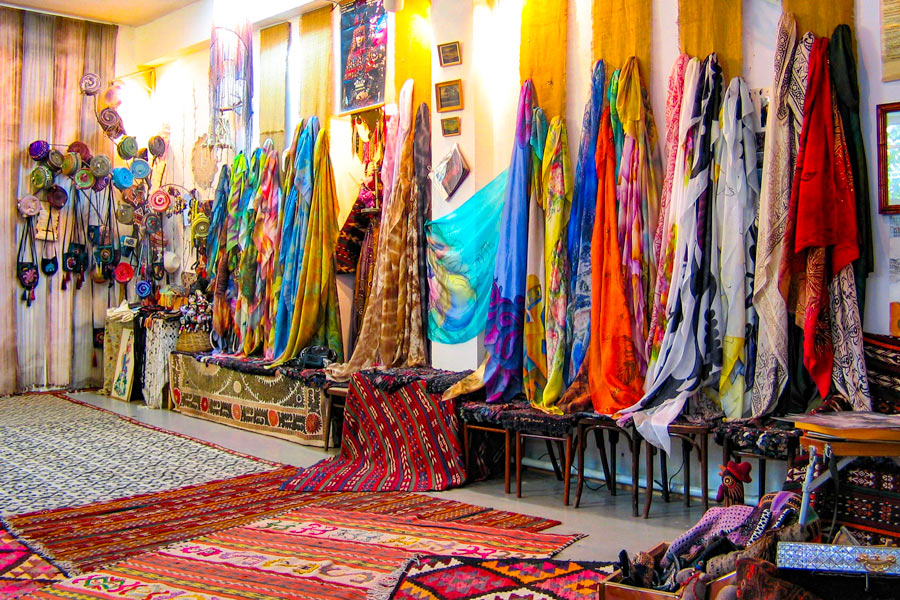
Nurmukhammad Valiev (Margilan) is a hereditary weaver and expert in silk and adrasa fabric production – a traditional blend of cotton and silk. Valiev carefully preserves centuries-old methods, incorporating local patterns and natural dyes to achieve authentic, vivid colors. At the same time, he experiments with modern elements, such as adding wool threads or introducing new textures. His workshop in Margilan is well known among locals and visitors to the Fergana Valley and was featured in the Homo Faber Guide in 2023.
Valentina Romanenko (Samarkand) is a fashion designer and founder of the Aiesha art workshop, where she creates clothing and accessories in the national style, using natural Uzbek silk and cotton. Visitors to her studio, the Valentina Romanenko Art Workshop, can observe the entire process of fabric dyeing, embroidery, and garment sewing – all carried out by skilled craftswomen, offering an intimate glimpse into this vibrant tradition.
Gavhar Ablizova (Tashkent) is a hereditary seamstress and master of national sewing with international experience. She specializes in traditional women's attire, particularly festive and wedding dresses in various styles, maintaining the cultural heritage of Uzbek garment design.
Elena Ladik (Samarkand) is a designer of distinctive national clothing and the owner of the Art Gallery “Happy Bird”, where she presents her one-of-a-kind garments crafted from natural fabrics, including both contemporary and vintage materials dating back to the Soviet era. The blend of traditional textiles with modern silhouettes gives her creations a unique and captivating character, making the gallery itself a vibrant showcase of her artistry.
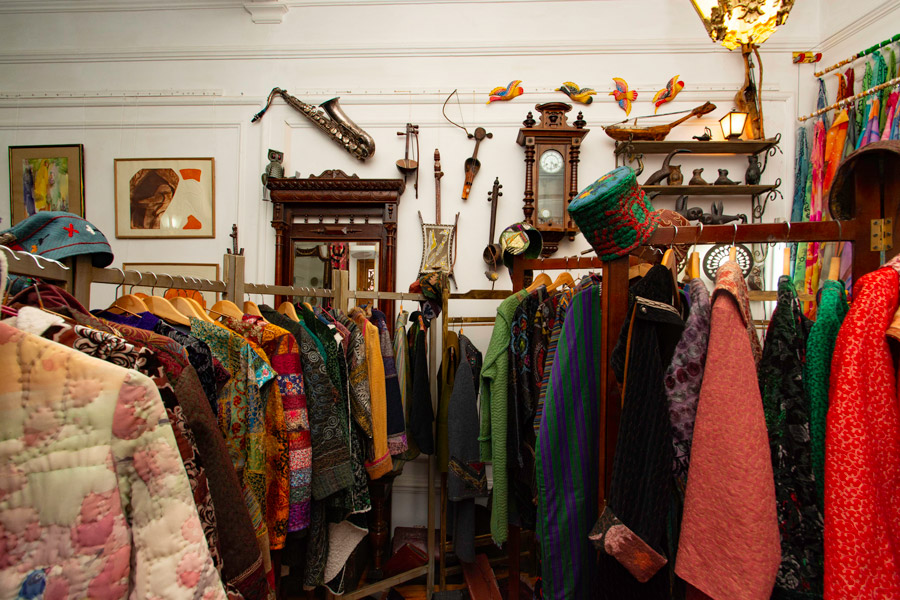
Alexey Manshaev (Tashkent) is a designer and the founder of the Kanishka brand and store, which offers a wide range of leather goods, Uzbek textiles, and woolen items. The brand’s products are highly popular for their exceptional quality and distinctive design, which blends bright modern touches with Uzbek national elements. There are several Kanishka stores in Tashkent, each featuring a minimalist interior inspired by Uzbek art and traditions.
Artisans of Miniature, Leather, Metal, and Paper
Miniature Painting
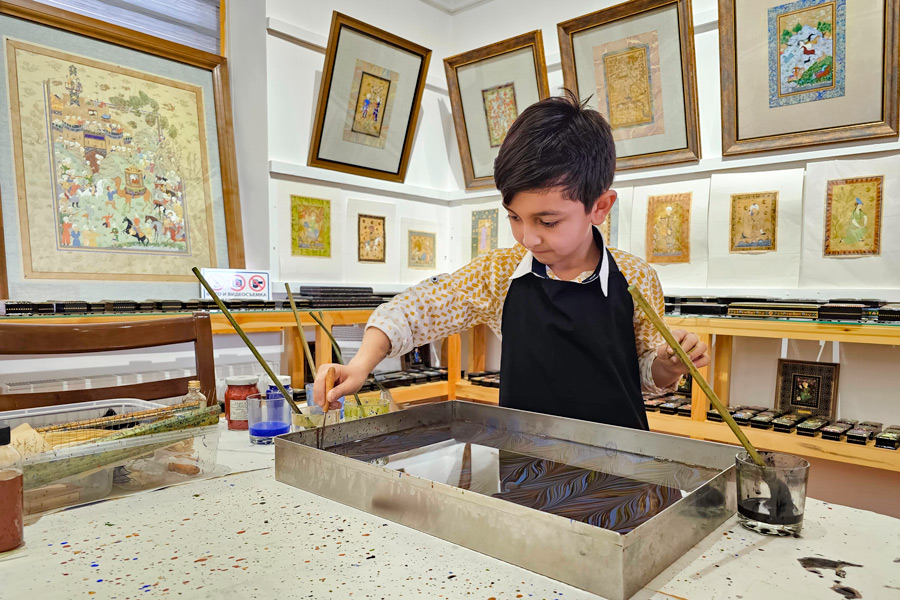
Davlat Toshev (Bukhara) is one of Uzbekistan’s most renowned miniature artists and a restorer of ancient books. His work has received international recognition, with exhibitions and festivals in Russia, France, Germany, Spain, and beyond. Toshev’s miniatures are celebrated for their vivid colors, intricate detail, and diverse subject matter, portraying religious blessings, folk heroes, and delicate scenes of nature and birds. He works on handmade silk paper, often with abstract, ethereal backgrounds. In Bukhara, at his Usto-Shogird Miniature Workshop and Center for Applied Arts, he teaches more than 50 students free of charge, passing on these exquisite traditions to a new generation.
Leatherwork
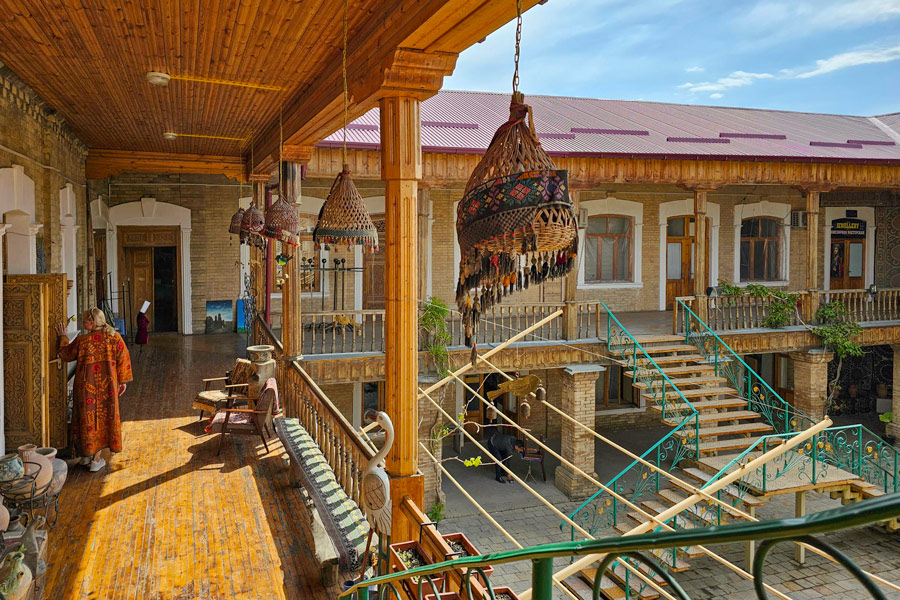
Vladimir and Alexander Ilyushin (Samarkand) are master craftsmen specializing in high-quality leather goods. Their original creations include bags, belts, traditional Uzbek skullcaps, and oriental-style shoes, all crafted with exceptional precision and distinctive, personalized design. At their Alibi Leather Workshop in the Craftsmen’s Center of Samarkand, visitors can explore their work firsthand, purchase ready-made pieces, or place custom orders with details such as personalized engraving, experiencing the full artistry of their craft.
Metal Embossing
Jurabek Sidikov (Bukhara) is a master of copper embossing and a featured artisan in the Homo Faber Guide. A student of the renowned craftsman Rakhmat Ruziev, Sidikov continues the Bukhara tradition of artistic metalwork. His pieces – ranging from delicate jewelry to large lyagans (serving trays) – are known for their elaborate plant-inspired ornamentation and fine craftsmanship. Particularly captivating are his decorative painted vessels, reminiscent of the legendary lamps from Eastern folktales.
Papermaking
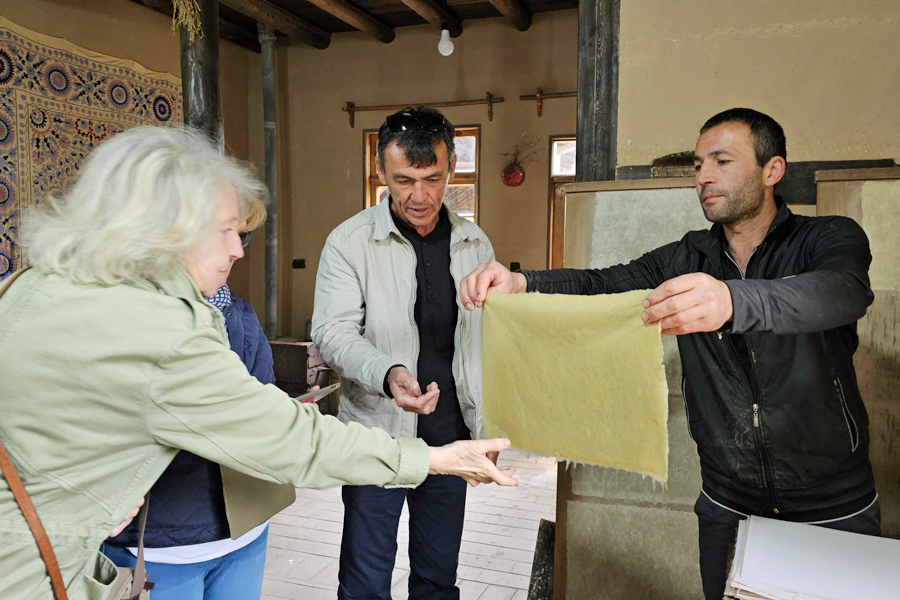
Zarif and Islam Mukhtarov (Samarkand) are skilled artisans who revived the ancient craft of Samarkand papermaking, a tradition dating back to the 7th century AD. Once lost for nearly two centuries, this technique was brought back to life by the Mukhtarov brothers, who successfully reconstructed the process for producing this remarkably durable paper, known to last up to 400 years. At their Konigil Meros Paper Factory in Samarkand, they not only manufacture this rare material but also welcome visitors with engaging factory tours and offer handmade souvenirs, sharing the legacy of this historic craft.


